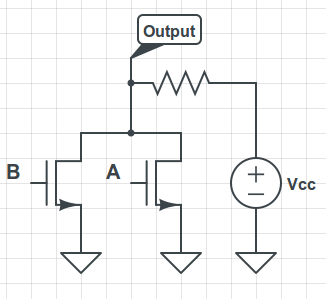
[Andrew Gibiansky] has just started a tutorial series called Computing with Transistors. It’s purpose is to pull back the many veiled layers between high level languages and the controlling of electrons. And fittingly this first post starts off by explaining voltage source, load, and current. Don’t be thrown by its simplicity though. [Andrew] quickly moves on to talk about switching transistors and how they are used to build gates like the OR NOR gate seen above.
If this is the least bit interesting you should also look back at the post about Nand 2 Tetris. It’s an online course that works its way through The Elements of Computing Systems text book. We’ve been following that journey ourselves, having made it through the hardware build in about a week. The assembler took about the same amount of time, and right now we’re in debugging hell trying to get the last function call and return parts of the VM translator to work right. We’ve used most of the skills needed in this journey before, but never all in one project. It really has shed a lot of light on the gaps in our knowledge, and we’re having a lot of fun at the same time!
[via Reddit]















I’m probably mistaken but isn’t that a NOR gate in the illustration? When ever either transistor’s gate goes high the output goes low.
I was about to post the same, yes, it is a NOR gate…
it also says so in the original article…
…yes, after the edit…..
@Mike
Are you thinking about porting it to FPGA when you’re done? I couldn’t stop thinking about it so i went out and got a Spartan 6 board, so now i’ll get to learn VHDL as a bonus! :)
@Mike
Are you thinking about porting it to FPGA when you’re done? I couldn’t stop thinking about it so i went out and got a Spartan 6 board, so now i’ll get to learn VHDL as a bonus! :)
I haven’t put much thought into that, but I do plan to get into FPGAs someday.
Sooner the better Mike. I did put it off for about a decade, thinking micros would be all I need. WRONG! you’ll have lots of fun doing stuff in hardware. The brutal speed and parallelism alone are worth it (cpus can’t touch that). Not to mention all the custom logic hardware you can put in SINGLE chips that you can’t buy anywhere.
After watching the TED talk, I bought the book to. His approach to education is enlightening. I hope we as a people take a closer look, maybe even implement those time tested concepts.
( in my best game show host voice ) I learn by failure all the time, And you can too !
virtual stack machines and cache algorithms over transistor meshes that make up ALU and I/O state machines.. done
CPUs are simple topology, the logistics behind their designs is what is impressive, and that you’ll never see cause it’s trade secrets..
Can’t wait for optical buses.. a mobile optical chip will be at least 3x throughput of a OCed i7..